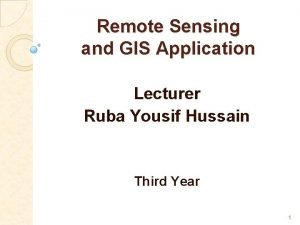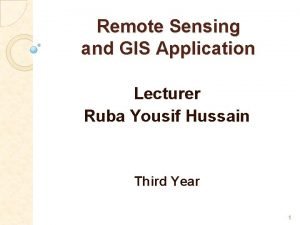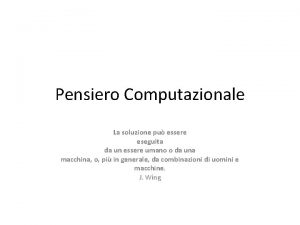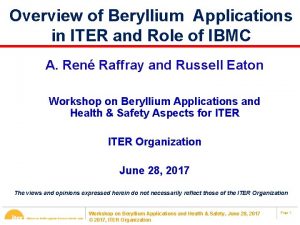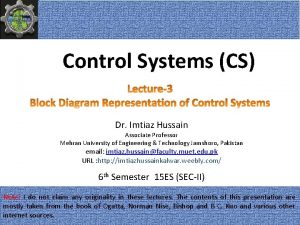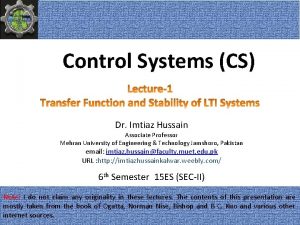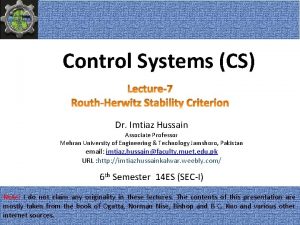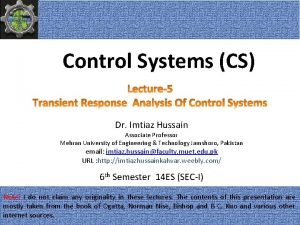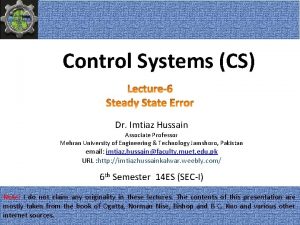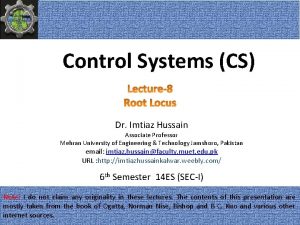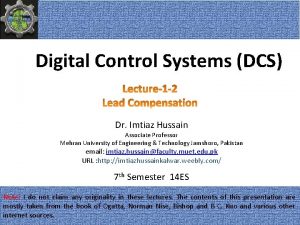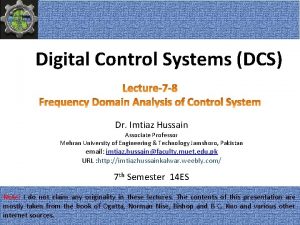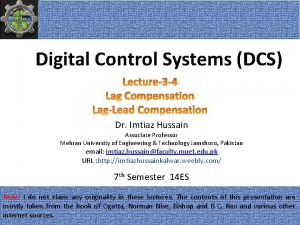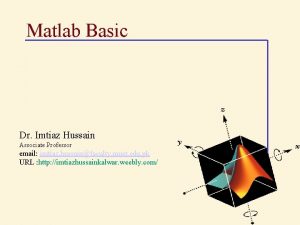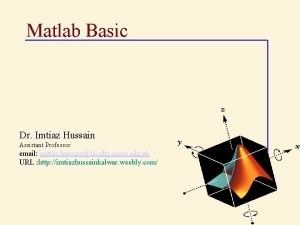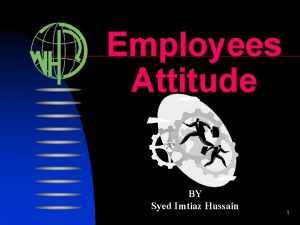Control Systems CS Dr Imtiaz Hussain Associate Professor



























































- Slides: 59

Control Systems (CS) Dr. Imtiaz Hussain Associate Professor Mehran University of Engineering & Technology Jamshoro, Pakistan email: imtiaz. hussain@faculty. muet. edu. pk URL : http: //imtiazhussainkalwar. weebly. com/ 6 th Semester 14 ES (SEC-I) Note: I do not claim any originality in these lectures. The contents of this presentation are mostly taken from the book of Ogatta, Norman Nise, Bishop and B C. Kuo and various other 1 internet sources.

Outline • Introduction to Signal Flow Graphs – Definitions – Terminologies – Examples • Mason’s Gain Formula – Examples • Signal Flow Graph from Block Diagrams • Design Examples 2

Introduction • Alternative method to block diagram representation, developed by Samuel Jefferson Mason. • Advantage: the availability of a flow graph gain formula, also called Mason’s gain formula. • A signal-flow graph consists of a network in which nodes are connected by directed branches. • It depicts the flow of signals from one point of a system to another and gives the relationships among the signals. 3

Fundamentals of Signal Flow Graphs • Consider a simple equation below and draw its signal flow graph: • The signal flow graph of the equation is shown below; • Every variable in a signal flow graph is represented by a Node. • Every transmission function in a signal flow graph is represented by a Branch. • Branches are always unidirectional. • The arrow in the branch denotes the direction of the signal flow. 4

Signal-Flow Graph Models 5

Signal-Flow Graph Models r 1 and r 2 are inputs and x 1 and x 2 are outputs 6

Signal-Flow Graph Models xo is input and x 4 is output f x 0 c a b x 1 d x 2 x 3 g h x 4 e 7

Terminologies • An input node or source contain only the outgoing branches. i. e. , X 1 • An output node or sink contain only the incoming branches. i. e. , X 4 • A path is a continuous, unidirectional succession of branches along which no node is passed more than ones. i. e. , X 1 to X 2 to X 3 to X 4 X 1 to X 2 to X 4 X 2 to X 3 to X 4 • A forward path is a path from the input node to the output node. i. e. , X 1 to X 2 to X 3 to X 4 , and X 1 to X 2 to X 4 , are forward paths. • A feedback path or feedback loop is a path which originates and terminates on the same node. i. e. ; X 2 to X 3 and back to X 2 is a feedback path. 8

Terminologies • A self-loop is a feedback loop consisting of a single branch. i. e. ; A 33 is a self loop. • The gain of a branch is the transmission function of that branch. • The path gain is the product of branch gains encountered in traversing a path. i. e. the gain of forwards path X 1 to X 2 to X 3 to X 4 is A 21 A 32 A 43 • The loop gain is the product of the branch gains of the loop. i. e. , the loop gain of the feedback loop from X 2 to X 3 and back to X 2 is A 32 A 23. • Two loops, paths, or loop and a path are said to be non-touching if they have no nodes in common. 9

Consider the signal flow graph below and identify the following a) b) c) d) e) f) g) Input node. Output node. Forward paths. Feedback paths (loops). Determine the loop gains of the feedback loops. Determine the path gains of the forward paths. Non-touching loops 10

Consider the signal flow graph below and identify the following • There are two forward path gains; 11

Consider the signal flow graph below and identify the following • There are four loops 12

Consider the signal flow graph below and identify the following • Nontouching loop gains; 13

Consider the signal flow graph below and identify the following a) b) c) d) e) f) g) Input node. Output node. Forward paths. Feedback paths. Self loop. Determine the loop gains of the feedback loops. Determine the path gains of the forward paths. 14

Input and output Nodes a) Input node b) Output node 15

(c) Forward Paths 16

(d) Feedback Paths or Loops 17

(d) Feedback Paths or Loops 18

(d) Feedback Paths or Loops 19

(d) Feedback Paths or Loops 20

(e) Self Loop(s) 21

(f) Loop Gains of the Feedback Loops 22

(g) Path Gains of the Forward Paths 23

Mason’s Rule (Mason, 1953) • The block diagram reduction technique requires successive application of fundamental relationships in order to arrive at the system transfer function. • On the other hand, Mason’s rule for reducing a signal-flow graph to a single transfer function requires the application of one formula. • The formula was derived by S. J. Mason when he related the signal -flow graph to the simultaneous equations that can be written from the graph. 24

Mason’s Rule: • The transfer function, C(s)/R(s), of a system represented by a signal-flow graph is; Where n = number of forward paths. Pi = the i th forward-path gain. ∆ = Determinant of the system ∆i = Determinant of the ith forward path • ∆ is called the signal flow graph determinant or characteristic function. Since ∆=0 is the system characteristic equation. 25

Mason’s Rule: ∆ = 1 - (sum of all individual loop gains) + (sum of the products of the gains of all possible two loops that do not touch each other) – (sum of the products of the gains of all possible three loops that do not touch each other) + … and so forth with sums of higher number of non-touching loop gains ∆i = value of Δ for the part of the block diagram that does not touch the ith forward path (Δi = 1 if there are no non-touching loops to the i-th path. ) 26

Systematic approach 1. Calculate forward path gain Pi for each forward path i. 2. Calculate all loop transfer functions 3. Consider non-touching loops 2 at a time 4. Consider non-touching loops 3 at a time 5. etc 6. Calculate Δ from steps 2, 3, 4 and 5 7. Calculate Δi as portion of Δ not touching forward path i 27

Example#1: Apply Mason’s Rule to calculate the transfer function of the system represented by following Signal Flow Graph Therefore, There are three feedback loops 28

Example#1: Apply Mason’s Rule to calculate the transfer function of the system represented by following Signal Flow Graph There are no non-touching loops, therefore ∆ = 1 - (sum of all individual loop gains) 29

Example#1: Apply Mason’s Rule to calculate the transfer function of the system represented by following Signal Flow Graph Eliminate forward path-1 ∆1 = 1 - (sum of all individual loop gains)+. . . ∆1 = 1 Eliminate forward path-2 ∆2 = 1 - (sum of all individual loop gains)+. . . ∆2 = 1 30

Example#1: Continue 31

Example#2: Apply Mason’s Rule to calculate the transfer function of the system represented by following Signal Flow Graph P 1 P 2 1. Calculate forward path gains for each forward path. 2. Calculate all loop gains. 3. Consider two non-touching loops. L 1 L 3 L 1 L 4 L 2 L 3 32

Example#2: continue 4. Consider three non-touching loops. None. 5. Calculate Δ from steps 2, 3, 4. 33

Example#2: continue Eliminate forward path-1 Eliminate forward path-2 34

Example#2: continue 35

Example#3 • Find the transfer function, C(s)/R(s), for the signal-flow graph in figure below. 36

Example#3 • There is only one forward Path. 37

Example#3 • There are four feedback loops. 38

Example#3 • Non-touching loops taken two at a time. 39

Example#3 • Non-touching loops taken three at a time. 40

Example#3 Eliminate forward path-1 41

Example#4: Apply Mason’s Rule to calculate the transfer function of the system represented by following Signal Flow Graph There are three forward paths, therefore n=3. 42

Example#4: Forward Paths 43

Example#4: Loop Gains of the Feedback Loops 44

Example#4: two non-touching loops 45

Example#4: Three non-touching loops 46

From Block Diagram to Signal-Flow Graph Models Example#5 H 1 R(s) E(s) X 1 G 1 - - - G 2 X 2 G 3 X 3 G 4 C(s) H 2 H 3 R(s) 1 E(s) G 1 X 1 G 2 X 2 G 3 -H 1 X 3 G 4 C(s) -H 2 -H 3 47

From Block Diagram to Signal-Flow Graph Models Example#5 R(s) -H 1 1 E(s) G 1 X 1 G 2 X 2 G 3 G 4 X 3 1 C(s) -H 2 -H 3 48

Example#6 - R(s) - X 1 + E(s) - -X 2 - -1 R(s) 1 X 1 Y 1 G 1 + + G 2 Y 2 G 1 E(s) 1 X 2 -1 C(s) G 2 -1 Y 1 -1 1 Y 2 1 C(s) 1 -1 49

Example#6 R(s) 1 E(s) -1 1 X 2 -1 G 1 G 2 Y 1 -1 1 Y 2 1 1 C(s) -1 7 loops: 3 ‘ 2 non-touching loops’ : 50

Example#6 R(s) 1 E(s) -1 1 X 2 -1 G 1 G 2 Y 1 -1 1 Y 2 1 1 C(s) -1 Then: 4 forward paths: 51

Example#6 We have 52

Example-7: Determine the transfer function C/R for the block diagram below by signal flow graph techniques. • The signal flow graph of the above block diagram is shown below. • There are two forward paths. The path gains are • The three feedback loop gains are • No loops are non-touching, hence • Because the loops touch the nodes of P 1, hence • Since no loops touch the nodes of P 2, therefore • Hence the control ratio T = C/R is 53

Example-6: Find the control ratio C/R for the system given below. • The signal flow graph is shown in the figure. • The two forward path gains are • The five feedback loop gains are • • All feedback loops touches the two forward paths, hence • Hence the control ratio T = There are no non-touching loops, hence 54

Design Example#1 55

Design Example#2 56

Design Example#2 57

Design Example#2 58

To download this lecture visit http: //imtiazhussainkalwar. weebly. com/ END OF LECTURE-4 59
 Promotion from associate professor to professor
Promotion from associate professor to professor Sep certification
Sep certification Tissue imtiaz dharker
Tissue imtiaz dharker Living space annotations
Living space annotations The right word by imtiaz dharker
The right word by imtiaz dharker Imtiaz munshi cpa
Imtiaz munshi cpa Living space imtiaz dharker analysis
Living space imtiaz dharker analysis Imtiaz alam md
Imtiaz alam md Tissue poem
Tissue poem Keeping you alive poem hussain manawer
Keeping you alive poem hussain manawer Dr azhar hussain
Dr azhar hussain Family tree of hazrat ali
Family tree of hazrat ali Hussain mujhe maaf karna lyrics
Hussain mujhe maaf karna lyrics Hanin hussain
Hanin hussain Rosie hussain
Rosie hussain Sehrish hussain
Sehrish hussain Waris husain
Waris husain Zahin hussain
Zahin hussain Maria hussain leeds
Maria hussain leeds Journey of imam hussain
Journey of imam hussain Dr shahid hussain psychiatrist
Dr shahid hussain psychiatrist Tarlf
Tarlf Maria hussain leeds
Maria hussain leeds Stephanie husan
Stephanie husan Hussain
Hussain Hussain
Hussain Dr insiya hussain
Dr insiya hussain Iftikhar hussain md
Iftikhar hussain md Mulazim hussain bukhari
Mulazim hussain bukhari Mulazim hussain bukhari
Mulazim hussain bukhari Tcs partner companies list
Tcs partner companies list Kabeer hussain
Kabeer hussain Akmol hussain
Akmol hussain Bcs student membership
Bcs student membership Tecniche associate al pensiero computazionale
Tecniche associate al pensiero computazionale The pyramid at chichen itza is most closely associate with
The pyramid at chichen itza is most closely associate with Lone star nursing
Lone star nursing Direct mapping advantage and disadvantage
Direct mapping advantage and disadvantage Hid cern
Hid cern Associate degree netherlands
Associate degree netherlands Laser alignment
Laser alignment Physician associate lecturer
Physician associate lecturer Rcog cpd
Rcog cpd Associate degree duo gift
Associate degree duo gift What is an associate director
What is an associate director Harper college
Harper college Iter project associate
Iter project associate Critical aad
Critical aad Lahc verify my fafsa
Lahc verify my fafsa Why critical reading is an active process of discovery
Why critical reading is an active process of discovery برنامهxx
برنامهxx Associate degree rmit
Associate degree rmit Adobe audition certification
Adobe audition certification Cincinnati state associate degrees
Cincinnati state associate degrees Safety associate
Safety associate Associate warden
Associate warden Customer kpi
Customer kpi Imeche associate membership
Imeche associate membership To associate
To associate Hea associate fellowship
Hea associate fellowship
























